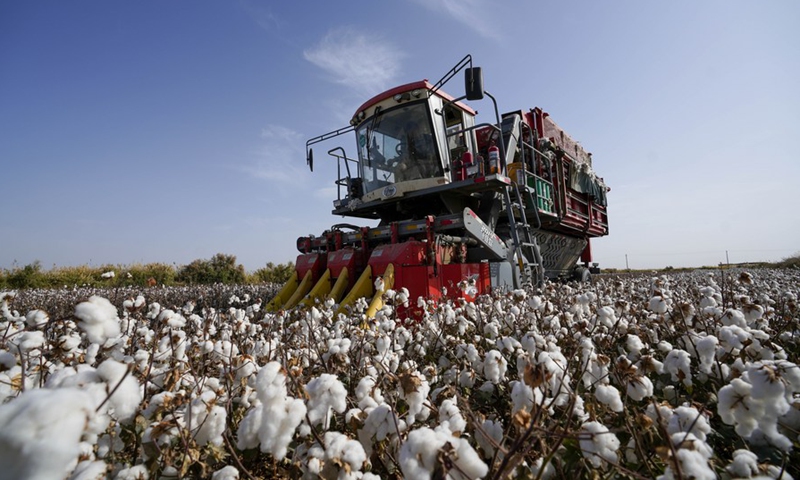
A cotton picker works in fields in Yuli County, northwest China's Xinjiang Uygur Autonomous Region, Oct. 15, 2021.(Photo: Xinhua)
As vast swathes of blooming cotton in northwest China's Xinjiang Uygur Autonomous Region awaits the harvest this month, technology adopted in planting, spraying and other processes have gradually manifested its effect.
A team of agronomists from multiple departments confirmed last week that the cotton yield in a demonstration test field reached a record high of 620.4 kg per mu, or 9,306 kg per hectare, in Yuli County of the Mongolian Autonomous Prefecture of Bayingolin, a major cotton production base in China.
Such yield, which was measured in three plots randomly selected in the 33-hectare test field on Oct. 15, was 26.2 percent higher than that of nearby ordinary farmland planted with the same cotton breed, said Qu Tao, the team leader from the agricultural technology extension center of the prefecture.
Qu said because of the weather change this year, the cotton yield is slightly lower than that of last year in general, but a new kind of fertilizer adopted in the test field has contributed to the bumper harvest.
"The organosilicon fertilizer can adjust the pH value of the saline land for a better soil structure," said Qu.
Xinjiang is home to up to one-third of China's saline and alkaline land, which has severely restricted the sustainable development of the region's agriculture. Therefore, the organosilicon fertilizer has brought tangible benefits to cotton farmers in improving the yield.
Shi Junyi, a cotton farmer in Yuli, decided to expand the cotton plantation area next year using the new fertilizer.
"With the technical support, I hope the yield will reach 700 kg per mu next year," he said.
Apart from upgrading soil structure, technology has liberated farmers' hands and transformed traditional agriculture into a modern one. From drone sprayers to cotton pickers, various types of machinery have become essential in the cotton field.
Cotton farmer Erken Reyimu said seeding, insecticide spraying and cotton-picking on his 33-hectare cotton field are all done by machines.
"With cotton yield reaching 400 kg per mu, I hopefully can bring home over 1 million yuan (about 155,500 U.S. dollars) this year," he said with a smile.
Using the income out of his cotton farm, he has bought an apartment for his elder son and a car for his elder daughter. He plans to buy a car for his younger son at the end of this year.
He Miao, deputy head of Yuli County, said the agricultural mechanization rate of the county with 66,000 hectares of cotton fields has reached 96 percent.
He added that the price of unginned cotton has increased from 7 yuan per kg last year to 12 yuan per kg this year, which will bring more income to farmers.
The cotton harvesting work is expected to finish by mid-November in the prefecture of Bayingolin, and more than 80 percent of the cotton field will be picked by machines, according to the prefectural government.
Xinjiang is the largest cotton-growing area in China. The region's cotton output hit 5.16 million tonnes in 2020, accounting for 87.3 percent of the total in the country.
